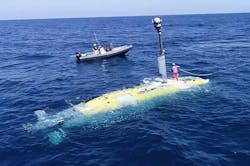Navy starts ramping-up production of large unmanned submarines for reconnaissance and special ops
THE MIL & AERO COMMENTARY – The U.S. Navy is heading in the direction of large unmanned submarines able to act as motherships for different kinds of unmanned underwater, surface, and aerial vehicles for undersea surveillance and special operations missions.
The U.S. Naval Sea Systems Command in Washington announced a $43 million order last month to the Boeing Defense, Space & Security segment in Huntington Beach, Calif., to build four Orca Extra-Large Unmanned Undersea Vehicles (XLUUVs).
What this could mean in practice could stretch limits of the imagination. Large autonomous undersea vessels like these could launch, recover, and recharge several different surveillance UUVs, infiltrate Navy SEALs and other special operations warfighters into contested marine areas, and even launch expendable surveillance unmanned aircraft near valuable enemy targets.
These kinds of large unmanned submarines also might be able to conduct covert bomb damage assessment, act as terrestrial communications relays, rescue downed aircraft pilots, and deliver sensitive supplies or sensor payloads to manned submarines on deployment.
The Lockheed Martin Rotary and Mission Systems segment in Riviera Beach, Fla., also is designing prototype Orca XLUUV systems.
One thing's clear: top Navy leaders like the idea of big autonomous submarines, and they're bound to order more of them soon.
U.S. military experts have been working on a large autonomous submersible mothership for the past several years, spearheaded by the U.S. Defense Advanced Research Projects Agency (DARPA) in Arlington, Va.
As far back as 2013, DARPA was asking industry to develop unmanned submarines designed to transport and deploy unmanned aerial vehicles (UAVs) and unmanned underwater vehicles (UUVs) stealthily close to enemy operations as part of the Hydra program.
The Hydra project sought modular payloads to operate inside a standardized enclosure to deploy a mix of UAVs and UUVs, depending on the military situation. Hydra sought to integrate existing and emerging technologies in new ways to create an alternate means of delivering a variety of sensor payloads, as well as UAVs and UUVs that could be carried into battle covertly.
Related: DARPA considers unmanned submersible mothership designed to deploy UAVs and UUVs
In 2015 DARPA asked industry to develop a payload-delivery system from an extra-large UUV, as part of the Hunter program. Hunter payloads were envisioned as persistent-surveillance sensors, weapons, or other UUVs and UAVs.
Also that year, the Boeing Co. and Lockheed Martin Corp. were involved in a DARPA project called Blue Wolf to develop revolutionary underwater propulsion and drag-reduction technologies to enable manned and unmanned military undersea vehicles to move through the water faster and more energy-efficiently than ever before.
Lockheed Martin also has done work for the U.S. Special Operations Command (SOCOM) Dry Combat Submersible (DCS) program to design an affordable mini-submarine able to transport Special Operations combat swimmers such as Navy SEALs covertly while minimizing swim time to keep the divers from becoming too exhausted to carry out their missions.
With last month's order to Boeing for four Orca Extra-Large Unmanned Undersea Vehicles (XLUUVs), apparently much of the research necessary to projects like this to fruition is winding up, and now it's time for production. Notice the order came from Naval Sea Systems Command, which primarily is involved with deployable Navy surface ships and submarines, not in research to develop enabling technologies.
Related: DARPA asks industry for large unmanned undersea vehicle advanced payload delivery system
The modular-construction Boeing Orca XLUUVs will be open-architecture reconfigurable UUVs able to provide autonomous guidance and control, navigation, situational awareness, communications, power distribution, energy and power, propulsion and maneuvering, and mission sensors, Navy officials say.
The new large UUVs will have well-defined interfaces for cost-effective future upgrades to capitalize on advances in technology and respond to threat changes. Each Orca XLUUV will have a modular payload bay, with defined interfaces to support current and future UUV payloads.
Boeing is building these large UUVs in Huntington Beach, City of Industry, El Cajon, and Ontario Calif.; Virginia Beach, Va.; Waukesha, Wis.; East Aurora and Farmingdale, N.Y.; Concord and Attleboro, Mass.; Camden and Fairfield, N.J.; and Smithfield, Pa. The four new Orca XLUUVs should be ready by June 2022.
It's not clear yet which segments of the Navy will be responsible for deploying and operating the Orca XLUUVs, or how these large autonomous submersible vessels will operate in the Navy's chain of command. One thing we do know: we'll see a lot more of these before too long.
Ready to make a purchase? Search the Military & Aerospace Electronics Buyer's Guide for companies, new products, press releases, and videos

